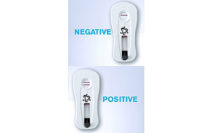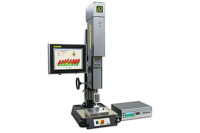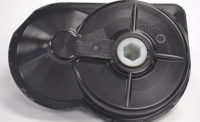Methicillin-resistant Staphylococcus aureus (MRSA) is a bacterium responsible for many hard-to-treat and life-threatening infections, including pneumonia and blood poisoning. MRSA is especially troublesome in hospitals, prisons and nursing homes, where patients with open wounds, invasive devices and weakened immune systems are at greater risk of infection.
Rapid identification of the organism is imperative for treatment. Medical device manufacturer Greiner Bio-One International has developed a diagnostic device, called Genspeed, that can detect this dangerous organism in just 75 minutes.
A swab sample is taken from an infected area and mixed with liquid reagents, which separate and amplify any MRSA DNA that might be present. The sample is deposited into a disposable plastic cartridge, which is then inserted into an electronic reader.
Inside the cartridge, capillary action draws the sample into microfluidic channels and then into a reservoir. Chemical markers inside the channels react with MRSA DNA. Light passing through the channels enables sensors to detect the bacteria.
Made from clear polystyrene, the cartridge is 75 millimeters long and 25 millimeters wide. The cartridge consists of two parts. The upper part is 1.5 millimeters thick. The bottom is just 0.15 millimeter thick.
The two halves are joined with a HiQ Dialog ultrasonic welder from Herrmann Ultrasonics Inc. It’s a tricky assembly. First, the cartridge must be leak-tight. Second, it must have a perfect visual appearance. That’s important not just from an aesthetic standpoint, but because the test relies on optoelectronics. Finally, the parts must fit perfectly. The microfluidic channels must remain open to achieve the capillary effect.
To meet those requirements, engineers started with part design. The upper part has an energy director, just 0.1 millimeter tall, that follows the path of the microfluidic channel. (An energy director is a sharply pointed triangular rib molded onto the surface of the part.) This ensures dimensionally precise joining without expelling molten plastic that could occlude the channel. A second energy director traces the outside edge of the part, ensuring a leak-tight assembly. Finally, four small spacer domes keep the reservoir open.
One advantage of ultrasonic welding is its targeted energy input, which permits controlled and dimensionally stable melting. Thanks to the energy director, the ultrasonic waves are focused on the joint without overheating the parts. In addition, the gentle vibrations do not affect the chemical markers in the channel.
While optimizing the process for this application, Herrmann engineers decided to partially mill away the outside seam geometries of the sonotrode. This improved the focus of the ultrasonic waves, prevented coupling at the surface, and reduced the mechanical impact on the lower part.
With the HiQ Dialog welder, the assembly process can be defined and optimized using a variety of weld modes. For the cartridge, the melt distance measured from a reference zero point was defined as a fixed shut-down parameter. In other words, the machine switches off ultrasonic vibrations when the programmed weld depth is reached.
By zeroing the reference point, the exact point at which the weld process is to start is calculated individually for each assembly. The weld depth is then always the same and the melt volume remains constant. For the cartridge, the weld depth is less than 0.1 millimeter.
The HiQ’s controller displays the weld process as a graph. After analysis of the graph, the process can be further optimized by defining tight process windows with minimum and maximum values. The curve for joining velocity is particularly important; it is a unique “fingerprint” and should ideally have a constant linear gradient. Under normal circumstances, a constant joining velocity guarantees a stable weld process with reproducible weld strength.
The ability of the HiQ welder to collect process data and limit unauthorized access to the controls was a key feature for Greiner, which has to meet strict FDA regulations.




